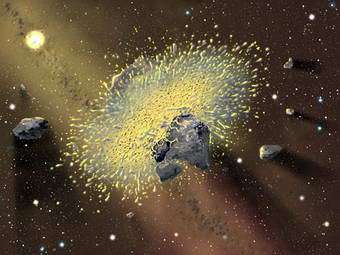Results published in Nature today from observations carried out from the Gemini and W.M. Keck Observatories in Hawaii have revealed details about a relatively young dusty star located about 300 light years away - helping to greatly improve our understanding of the formation of Earth-like planets.
Image: Artist's conception of a possible collision around BD +20 307 that might have created some of the dust observed in the recent Gemini/ Keck observations. The collisions responsible for the dust could range in size from asteroids (approximated here) to planets the size of the Earth or Mars. Image Credit: Gemini Observatory/Jon Lomberg.
The star, going by the unassuming name of BD +20 307, is shrouded by the dustiest environment ever seen so close to a Sun-like star well after its formation. The warm dust is believed to be from recent collisions of rocky bodies at distances from the star comparable to that of the Earth from the Sun. This finding supports the idea that comparable collisions of rocky bodies occurred early in our solar system's formation about 4.5 billion years ago. Additionally, this work could lead to more discoveries of this sort which would indicate that the rocky planets and moons of our inner solar system are not as rare as some astronomers suspect.
"We were lucky. This set of observations is like finding the proverbial needle in the haystack," said Inseok Song, the Gemini Observatory astronomer who led the U.S.-based research team. "The dust we detected is exactly what we would expect from collisions of rocky asteroids or even planet-sized objects, and to find this dust so close to a star like our Sun bumps the significance way up. However, I can't help but think that astronomers will now find more average stars where collisions like these have occurred."
For years, astronomers have patiently studied hundreds of thousands of stars in the hopes of finding one with an infrared dust signature (the characteristics of the starlight absorbed, heated up and reemitted by the dust) as strong as this one at Earth-to-Sun distances from the star. "The amount of warm dust near BD+20 307 is so unprecedented I wouldn't be surprised if it was the result of a massive collision between planet-size objects, for example, a collision like the one which many scientists believe formed Earth's moon," said Benjamin Zuckerman, UCLA professor of physics and astronomy, member of NASA's Astrobiology Institute, and a co-author on the paper. The research team also included Eric Becklin of UCLA and Alycia Weinberger formerly at UCLA and now at the Carnegie Institution.
BD +20 307 is slightly more massive than our Sun and lies in the constellation Aries. The large dust disk that surrounds the star has been known since astronomers detected an excess of infrared radiation with the Infrared Astronomical Satellite (IRAS) in 1983. The Gemini and Keck observations provide a strong correlation between the observed emissions and dust particles of the size and temperatures expected by the collision of two or more rocky bodies close to a star.
Because the star is estimated to be about 300 million years old, any large planets that might orbit BD +20 307 must have already formed. However, the dynamics of rocky remnants from the planetary formation process might be dictated by the planets in the system, as Jupiter did in our early solar system. The collisions responsible for the observed dust must have been between bodies at least as large as the largest asteroids present today in our solar system (about 300 kilometres across). "Whatever massive collision occurred, it managed to totally pulverize a lot of rock," said team member Alycia Weinberger.
Given the properties of this dust, the team estimates that the collisions could not have occurred more than about 1,000 years ago. A longer history would give the fine dust (about the size of cigarette smoke particles) enough time to be dragged into the central star.
The dusty environment around BD +20 307 is thought to be quite similar, but much more tenuous than what remains from the formation of our solar system. "What is so amazing is that the amount of dust around this star is approximately one million time greater than the dust around the Sun," said UCLA team member Eric Becklin. In our solar system the remaining dust scatters sunlight to create an extremely faint glow called the zodiacal light. It can be seen under ideal conditions with the naked eye for a few hours after evening or before morning twilight (see images).
The team's observations were obtained using MICHELLE, a mid-infrared spectrograph/imager on Gemini North, and the Long Wavelength Spectrograph (LWS) on Keck II.
MICHELLE, designed and built at the UK Astronomy Technology Centre (UK ATC) in Edinburgh was first commissioned to the UK Infrared Telescope in summer 2001 before moving to Gemini North in early 2003.
Dr Alistair Glasse from the UK Astronomy Technology Centre, comments, "It is great to see MICHELLE producing excellent results in the relatively unexplored region of mid infrared. Such wavelengths are emitted most strongly by bodies at temperatures close to that of our own Earth and so this research will help us gain a greater understanding of star and planet formation."
Background
Michelle is a mid-infrared spectrometer and imager for use on both the United Kingdom Infrared Telescope (UKIRT) and the Gemini North telescopes at the thermal infrared wavelengths between 8 and 25 microns. Michelle was commissioned on UKIRT in summer 2001, and was moved to Gemini North for use in early 2003.
Michelle provides new capabilities in the relatively unexplored mid-infrared spectral region. Typical research fields will include the physics and chemistry of interstellar dust, the effects of interstellar shocks and polarimetry of the interstellar medium. Michelle results will have a major influence on our understanding of star and planet formation, including the evolution of proto-planetary disks, the formation of brown dwarf stars and in untangling the nature of starburst galaxies and active galactic nuclei.
Source: PPARC
























